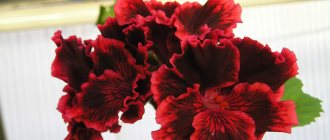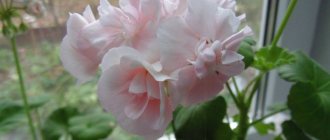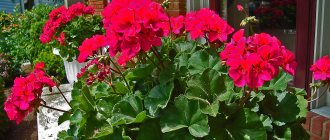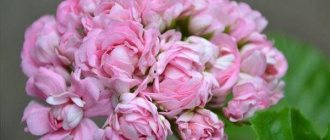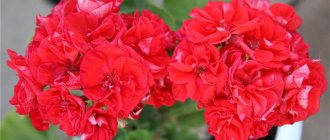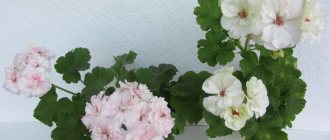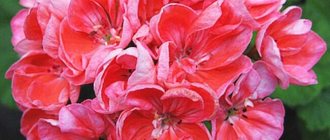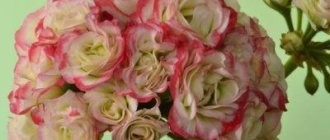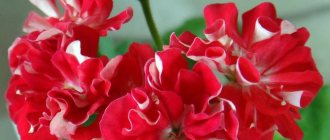Description and characteristics of cultivation
Interestingly, among all the variety of varieties, it is dwarf geranium that is becoming increasingly popular. It has many advantages. For example, such a plant will take its rightful place on the windowsill and fit perfectly into any of your flower collections.
It is grown in a compact pot, since the flower is very miniature. Nevertheless, its small dimensions do not prevent it from blooming magnificently. Another important advantage of this group of geraniums is that formative pruning of such a flower specimen is not necessary at all.
Caring for dwarf pelargonium varieties at home is not too labor-intensive; even a beginner can handle it. However, take some recommendations into account so as not to harm your indoor flowers. For example, like most geraniums, dwarf pelargonium does not like waterlogged soil - it will cause the rhizome to rot before you even blink an eye. That's why remember two things:
- The plant substrate should be moistened in moderation;
- The soil must contain sand or vermiculite. Such components are useful because they absorb excess moisture, and you do not have to correct the consequences of waterlogging the soil.
You will certainly be able to care for low-growing varieties of pelargonium. Over time, many gardeners begin to expand their collection of dwarf geraniums. This can be done easily and at home, no extra costs will be required.
How are these flowers propagated? It is best to start this procedure at the end of February or early March. It is during this period that the plant gradually comes to its senses after wintering, and its vital processes are activated. First of all, cut the cutting with two internodes, and then dry it thoroughly.
The next stage is planting in nutrient soil. It is not recommended to cover the top of the cutting with glass or film - this will only create an excessively humid environment for the geranium, which can have a detrimental effect on it. Miniature cuttings of pelargonium will very quickly take root in a new place. The main thing is to place the pot with the shoots in a well-lit place. Under favorable conditions, within a month you will receive a fully rooted plant.
Of course, you can’t do without transplanting homemade miniature geraniums. This procedure is not performed very often. If you notice that the flower has grown sufficiently, and, most likely, there is no longer enough space for the rhizome in the mini-pot, you can place it in a slightly larger pot. But don’t overdo it: if you plant a plant in a flowerpot that is too large, it may simply die, because the root system will not fill the bottom of the container, and without this the flower will not begin to develop.
In order for pelargonium varieties Dovepoint or pelargonium Barnstondale to delight you with its lush and long-lasting flowering, you need to take care of this yourself. You can't do without feeding. Nutrient mixtures can be added to the substrate a month after planting the plant in its permanent place.
Purchase either universal nutritional formulations or special fertilizers for homemade geraniums. You should not neglect feeding the flowers, since if there is a deficiency of organic and mineral substances in the soil, the plant may suffer from chlorosis or blackleg (fungal disease).
Pelargonium Saxdalens Selma
Zonal pelargonium Saxdalens Selma forms a large, strong bush, distinguished not only by powerful shoots, but also by voluminous beautiful inflorescences consisting of soft pink flowers. Plants of this variety bloom beautifully and respond to care. The bush is small, easily branching.
Many gardeners pay attention to the unusual structure of spectacular pink flowers, which are more reminiscent of rosaceous varieties.
The best varieties
There are more and more new varieties of pelargonium. That is why it is worth considering the most remarkable specimens. Only this way can you make an informed choice and purchase plants that will certainly decorate your home. Among the popular dwarf species of pelargonium, the following varieties are distinguished:
- Madame Maleron. If all previous varieties of pelargonium were distinguished by the presence of bright inflorescences, then this variety does not bloom at all. Its main advantage is its beautiful dark green leaves with a light border;
- Pac Harmony. The flowers of this plant are quite large, semi-double, and have a rich pink color;
- Only Joss. The key advantage of this specimen is the presence of bright, berry-red flowers. There is a slight light inclusion in the center of the bud;
Features of pelargoniums PAC
- Peculiarities
- Varieties
- Growing
The name itself - pelargonium - sounds wonderful. However, to grow this wonderful flower, you need to take into account as many subtleties as possible. This fully applies to PAC pelargoniums.
Why is the flower considered Her Majesty among geraniums?
These are noticeable spreading plants, growing up to 50 cm.
They delight gardeners with large (up to 7 cm in diameter, or even larger) flowers of various colors, both plain (albeit with dark stripes or spots running along the veins) and variegated. Often they also have corrugated or wavy edges of the petals (the so-called double flowers).
The leaves of these flowers resemble maple leaves, but smaller and more “toothed.”
If other geraniums (say, zonal) can bloom all year without ceasing, then Her Majesty deigns to bloom for only 3-4 months. And even then, if the flower is not given winter rest, the flowers may not wait.
The best varieties of royal pelargoniums
There are a lot of them these days—more than one hundred. Therefore, you can consider this list of the best as my IMHO... But in our store they are the most popular ones. Looking at the photo, it’s not hard to guess why!
Ann Hoystead. Medium-high variety (grows up to 40 cm). It is distinguished by red-burgundy petals with a deep dark middle part and a light edge.
Askham Fringed Aztec. An even shorter (up to 30 cm) variety that has white flowers with “cut” petals at the tips and pink patterns in the center.
Black Prince. A variety with deep burgundy flowers, each petal of which is bordered by a contrasting light stripe. Grows up to 40 cm.
Bushfire. It has scarlet flowers, in the depths of which there are dark spots. The height of the bushes is up to half a meter.
Carisbrooke. A relatively tall (up to 45 cm) variety with pink flowers. Terry petals are decorated with crimson stripes and strokes.
Georgina Blythe. Another red variety, this time low-growing (no higher than 35 cm). The center of the flowers is white, the petals are slightly terry.
Joy. Joy differs from the previous variety in that it has a greenish rather than white center and the absence of dark spots and veins. It also has slightly double, red petals (but no longer with orange, but rather with a pinkish tint). The bushes of the variety are tall - up to 45 cm, but the flowers are small - a maximum of 4.5 cm in diameter.
Lavender Grand Slam. Terry pink variety with burgundy centers. It grows up to 40 cm, standard for royal pelargonium.
Lord Bute. The variety is somewhat reminiscent of Black Prince, but its flowers are even darker - deep wine color, edged with a dark pink stripe. The bush has a height of 45 cm. This variety cannot be called terry, but still the petals are slightly curved at the edges.
Margaret Stoley. This is one of the most variegated varieties. The red petals have spots, veins, and borders - in addition, their shape is also terry. The advantage of Margaret Stoli is that despite the very compact size of the bush (it grows up to 30 cm), it is decorated with relatively large flowers - their diameter reaches 6 cm.
Morwenna. This is the darkest of the varieties presented in this “top”. Morwenna's petals are burgundy, iridescent almost black, and are also wavy along the edges. And, although the bush of this variety is small, its flowers are very large.
Rimfire. These wavy flowers seem to bring together all the shades of red. In addition, they are also quite large.
White Glory. Tall (45 cm) bushes are decorated with “fluffy” white flowers. They are also giants among pelargoniums - they reach 7.5 cm in diameter.
The varieties Candy Flowers or Candy Flowers (originally Candy Flowers) deserve special attention. They are decorated with two-color flowers with characteristic spots that do not appear on every petal.
In this “series” there are several varieties, the names of which reflect the main shade of the petals:
- Candy Flowers Bicolor (pink flowers, as in the photo above),
- Bright Red (cherry flowers with black spots on the petals),
- Dark Red (velvety dark red flowers with almost black spots - interestingly, the reverse side of the flowers has a lighter shade).
Important! Almost all varietal pelargonium flowers of “royal blood” do not have that characteristic aroma that not everyone can stand (that is, simply unpleasant). Therefore, they can be safely placed in the living room and even the bedroom.
What it is?
Pelargonium Stellar owes its appearance to the Australian hybridizer Ted Both, who in 1960 crossed several species of zonal pelargoniums and as a result received this beautiful plant.
The appearance of pelargonium in Eurasia occurred more than four centuries ago. Ships traveling from England and Holland to India stopped at the Cape of Good Hope and bought plants there for collectors from Europe. The Cape Province of South Africa is considered the birthplace of pelargoniums .
Pelargoniums acquired their name only in 1789, when the Geraniaceae family was divided into two separate genera Geranium (geranium) and Pelargonium (pelargonium). At the moment, more than 250 species belong to the genus Pelargonium.
Botanical description
These are perennial plants - herbaceous or subshrubs, with straight, branched or creeping stems. The flowers of this type of pelargonium are full of variety of colors and are collected in umbrella inflorescences. The fruit is a capsule with sepals that opens from bottom to top.
Appearance and features
Stellars are rightfully considered the most beautiful flowers of the pelargonium family. The original shape of the leaves, reminiscent of maple, is represented by a wide range of colors: shades of green, golden, chocolate, red and their combinations.
The flowers of the plant are shaped like stars , and in combination with double leaves and petals, stellars look elegant, spectacularly bright and cannot go unnoticed.
Photo of the plant
Here you can see a photo of star pelargonium:
How to care for such a flower
- Lighting. It should be bright, but diffused (shade the flower at least on a hot summer afternoon). If the plant grows in the shade, it will stretch out unattractively, “looking” for light, and, moreover, it may drop its buds, or even refuse to set them at all.
- Temperature. Royal geranium loves warmth. You can keep it on a closed balcony, but you can’t take it out into the open or into the garden, since the flower is very sensitive to drafts.
- Watering. As soon as the top of the soil dries out (in summer), pour plenty of water into the pot. Although pelargonium will not die if it “dries out” a little, it likes frequent watering.
- Spraying. If the air is dry, it is better to irrigate the flower with a spray bottle. But so that after this the sun does not hit the leaves, otherwise it will end in a burn (dew droplets dangerously refract the light, increasing its intensity). So spray your pet in the evening. If you do not spray the flower in the heat, aphids and other pests may grow on the leaves, which are difficult to remove.
- Circumcision. As with petunias, dried leaves and faded flowers must be cut off from pelargonium all the time.
- Nutrition. This is a necessity if you expect a “cap” flowering of your varietal beauty. A mineral complex fertilizer for decorative flowerpots will suit you. Apply it in spring and summer.
Winter dormancy is the key to flowering pelargonium
The plant should be kept at a low temperature (from 10 to 12, maximum 15 degrees).
Since geranium almost does not grow in the cold, which means it uses less water, reduce watering and pour very little water into the soil.
But take care of the lighting of the flower - keep it in the same window, and if it seems to you that there is not enough light for the plant, move the geranium to the room where the light bulb is most often on. Additional illumination with a phytolamp may also be relevant.
Fertilizers should be completely abandoned, not given in autumn and winter.
Competition “The most abundantly flowering pelargonium”
Moderator: Floriana
Competition “The most abundantly flowering pelargonium”
Post by Nimfea » Mar 27, 2016, 9:43 pm
Let's resume this competition.
Competition “The most abundantly flowering pelargonium”
Participants in the competition must show a full-length photo of a blooming pelargonium so that you can see the size of the plant and the number of flowers on it. So, take pictures of your favorites in spring and summer! The plant can be indoor, balcony, garden, the main thing is that it is taken in a neat condition and there should be no clutter in the background. The photo and plant must be yours. If you know the name of the variety, then sign for a better search on the web for our competition.
The competition will last from March 28 to September 15, 2016. All competition participants will receive a prize - a virtual medal for participating in the competition.
Competition “The most abundantly flowering pelargonium”
Post by Galina55 » March 29, 2016, 10:20
I have the most profusely blooming Brookside Rosa.
Competition “The most abundantly flowering pelargonium”
Post by Callirya » Apr 01, 2016, 00:02
Competition “The most abundantly flowering pelargonium”
Post by Bagiro4ka » April 16, 2016, 8:30 pm
Barnstone Dale ampelous ivy leaf. From spring to October everything is in flowers.
Competition “The most abundantly flowering pelargonium”
Posted by mirioran » April 16, 2016, 9:19 pm
Competition “The most abundantly flowering pelargonium”
Post by NadiyaB » April 17, 2016, 00:42
Competition “The most abundantly flowering pelargonium”
Post by MAK » April 17, 2016, 02:05
Competition “The most abundantly flowering pelargonium”
Post by Olga55 » April 17, 2016, 09:28
Little Bloom Jim Haughton
!
Competition “The most abundantly flowering pelargonium”
Post by Bagiro4ka » April 17, 2016, 8:13 pm
My favorite PAC Mexico Ruby
Competition “The most abundantly flowering pelargonium”
Post by Pepino » April 18, 2016, 02:07 pm
Competition “The most abundantly flowering pelargonium”
Post by Nimfea » April 18, 2016, 05:41 pm
Competition “The most abundantly flowering pelargonium”
Post by LiliyaYa » 01 Jun 2016, 17:30
For summer decoration of windows at the dacha, I grow various pelargoniums. One of my favorites, ivy leaf
Competition “The most abundantly flowering pelargonium”
Post by Larchen » 01 Jun 2016, 18:47
Competition “The most abundantly flowering pelargonium”
Post by Natalia Korkotko » June 01, 2016, 11:08 pm
In principle, my Debby (sport) did not bloom as profusely as it could have. I have to beat my hands off for autumn pruning, and I understand this perfectly well. But nothing can be changed. Take this one.
Why is the flower considered Her Majesty among geraniums?
These are noticeable spreading plants, growing up to 50 cm.
They delight gardeners with large (up to 7 cm in diameter, or even larger) flowers of various colors, both plain (albeit with dark stripes or spots running along the veins) and variegated. Often they also have corrugated or wavy edges of the petals (the so-called double flowers).
The leaves of these flowers resemble maple leaves, but smaller and more “toothed.”
If other geraniums (say, zonal) can bloom all year without ceasing, then Her Majesty deigns to bloom for only 3-4 months. And even then, if the flower is not given winter rest, the flowers may not wait.
The best varieties of royal pelargoniums
There are a lot of them these days—more than one hundred. Therefore, you can consider this list of the best as my IMHO... But in our store they are the most popular ones. Looking at the photo, it’s not hard to guess why!
Ann Hoystead. Medium-high variety (grows up to 40 cm). It is distinguished by red-burgundy petals with a deep dark middle part and a light edge.
Askham Fringed Aztec. An even shorter (up to 30 cm) variety that has white flowers with “cut” petals at the tips and pink patterns in the center.
Black Prince. A variety with deep burgundy flowers, each petal of which is bordered by a contrasting light stripe. Grows up to 40 cm.
Bushfire. It has scarlet flowers, in the depths of which there are dark spots. The height of the bushes is up to half a meter.
Carisbrooke. A relatively tall (up to 45 cm) variety with pink flowers. Terry petals are decorated with crimson stripes and strokes.
Georgina Blythe. Another red variety, this time low-growing (no higher than 35 cm). The center of the flowers is white, the petals are slightly terry.
Joy. Joy differs from the previous variety in that it has a greenish rather than white center and the absence of dark spots and veins. It also has slightly double, red petals (but no longer with orange, but rather with a pinkish tint). The bushes of the variety are tall - up to 45 cm, but the flowers are small - a maximum of 4.5 cm in diameter.
Lavender Grand Slam. Terry pink variety with burgundy centers. It grows up to 40 cm, standard for royal pelargonium.
Lord Bute. The variety is somewhat reminiscent of Black Prince, but its flowers are even darker - deep wine color, edged with a dark pink stripe. The bush has a height of 45 cm. This variety cannot be called terry, but still the petals are slightly curved at the edges.
Margaret Stoley. This is one of the most variegated varieties. The red petals have spots, veins, and borders - in addition, their shape is also terry. The advantage of Margaret Stoli is that despite the very compact size of the bush (it grows up to 30 cm), it is decorated with relatively large flowers - their diameter reaches 6 cm.
Morwenna. This is the darkest of the varieties presented in this “top”. Morwenna's petals are burgundy, iridescent almost black, and are also wavy along the edges. And, although the bush of this variety is small, its flowers are very large.
Rimfire. These wavy flowers seem to bring together all the shades of red. In addition, they are also quite large.
White Glory. Tall (45 cm) bushes are decorated with “fluffy” white flowers. They are also giants among pelargoniums - they reach 7.5 cm in diameter.
The varieties Candy Flowers or Candy Flowers (originally Candy Flowers) deserve special attention. They are decorated with two-color flowers with characteristic spots that do not appear on every petal.
In this “series” there are several varieties, the names of which reflect the main shade of the petals:
- Candy Flowers Bicolor (pink flowers, as in the photo above),
- Bright Red (cherry flowers with black spots on the petals),
- Dark Red (velvety dark red flowers with almost black spots - interestingly, the reverse side of the flowers has a lighter shade).
Important! Almost all varietal pelargonium flowers of “royal blood” do not have that characteristic aroma that not everyone can stand (that is, simply unpleasant). Therefore, they can be safely placed in the living room and even the bedroom.
Types of pelargonium
In total, there are over 250 varieties of the Pelargonium family alone. The entire geranium genus has many more variants. But only certain species have become widely known. Based on general features, they can be divided into 6 categories.
Fragrant pelargoniums
As the name suggests, these varieties are famous for their distinct aroma. Keep this in mind when choosing home flowers, because their smell sometimes causes a headache.
These pelargoniums are often quite inconspicuous. These are loose branched bushes with variegated palmate or lobed leaves. The flowers are miniature, not so frequent, pale or pink.
Such geraniums can smell like herbs, fruits and berries, and even more complex compositions. They are especially appreciated by perfumers.
Ivy-leaved pelargoniums
The variety got its name due to its resemblance to ivy, which spreads and wraps around the base; elongated shoots grow up to a meter. This is an interesting decorative covering solution. Dense leaves with a smooth and bright surface are also reminiscent of ivy.
How to care for such a flower
- Lighting. It should be bright, but diffused (shade the flower at least on a hot summer afternoon). If the plant grows in the shade, it will stretch out unattractively, “looking” for light, and, moreover, it may drop its buds, or even refuse to set them at all.
- Temperature. Royal geranium loves warmth. You can keep it on a closed balcony, but you can’t take it out into the open or into the garden, since the flower is very sensitive to drafts.
- Watering. As soon as the top of the soil dries out (in summer), pour plenty of water into the pot. Although pelargonium will not die if it “dries out” a little, it likes frequent watering.
- Spraying. If the air is dry, it is better to irrigate the flower with a spray bottle. But so that after this the sun does not hit the leaves, otherwise it will end in a burn (dew droplets dangerously refract the light, increasing its intensity). So spray your pet in the evening. If you do not spray the flower in the heat, aphids and other pests may grow on the leaves, which are difficult to remove.
- Circumcision. As with petunias, dried leaves and faded flowers must be cut off from pelargonium all the time.
- Nutrition. This is a necessity if you expect a “cap” flowering of your varietal beauty. A mineral complex fertilizer for decorative flowerpots will suit you. Apply it in spring and summer.
Winter dormancy is the key to flowering pelargonium
The plant should be kept at a low temperature (from 10 to 12, maximum 15 degrees).
Since geranium almost does not grow in the cold, which means it uses less water, reduce watering and pour very little water into the soil.
But take care of the lighting of the flower - keep it in the same window, and if it seems to you that there is not enough light for the plant, move the geranium to the room where the light bulb is most often on. Additional illumination with a phytolamp may also be relevant.
Fertilizers should be completely abandoned, not given in autumn and winter.
